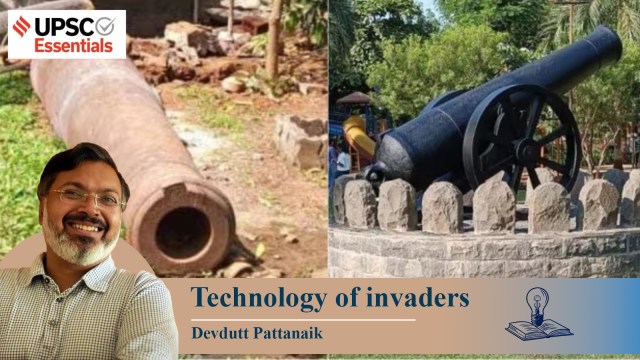© IE Online Media Services Pvt Ltd
Latest Comment
Post Comment
Read Comments
 The Mughals introduced the cannon in Indian warfare. The image shows a cannon found buried in marshy soil; (right) after its restoration by the BMC. (Express Photo)
The Mughals introduced the cannon in Indian warfare. The image shows a cannon found buried in marshy soil; (right) after its restoration by the BMC. (Express Photo)We know that from the 10th century, horse‑breeding groups from Afghanistan and Central Asia invaded India in successive waves. The early invaders simply looted the gold‑rich temples of the land. The later invaders, after the 12th century, established Sultanates to exploit India’s vast agricultural wealth and to control trade routes.
Religious aspects of these invasions often receive enough attention – how temples were replaced by mosques, minarets, tombs, palaces and forts. But this communal narrative usually overlooks technological transformation. Few discuss the new technologies that arrived with these invaders—technologies that Indians initially looked down upon.
It is known that Rajput warriors of India preferred death to dishonour and even glorified defeat – so long as they did not turn their backs on the battlefield. Their values were shakti (strength) and bhakti (passion, devotion). Yukti, or strategy, was looked down upon..
By contrast, the Afghans and Central Asians who entered India brought new military strategies that helped them win wars – strategies they used to survive on the Central Asian steppes and mountainous terrain, closely related to their horse‑breeding practices.
The Afghans and Turks knew the Parthian shot, an ancient steppe‑developed technique in which a mounted archer, while riding away, would twist his body to shoot backwards—feigning retreat, then ambushing enemies who presumed victory. This was seen as cowardice and trickery by Rajputs but as a brilliant war manoeuvre by Central Asian tribes.
It is not that the Rajputs did not know archery. The Prithviraj Raso speaks of how the Rajput king can shoot targets even when blind because he knows the art of locating a target by simply hearing the sound (shabd-bhedi baan). In Hindu mythology, though, kings who could shoot such arrows without looking at the target were seen as overconfident, who suffered for their pride.
For example, Dasharatha of the Ramayana shoots such an arrow thinking he is hearing the sound of an animal drinking water, and ends up striking a boy, Shravan Kumar, who was collecting water for his blind parents.
Rarely are we told of the complex logistical journey involving 30,000 camels carrying water and fodder for horses. That enabled Mahmud of Ghazni to take the most unusual route to Somanth through the Thar Desert, catching the guardians of the Somnath temple by surprise.
Then there was the Mongol hunting technique – the negre (encirclement) – whereby cavalry surrounded the enemy like hunters cornering prey.
The Khiljis were able to destroy many mud forts in South India because they deployed catapults and other siege weapons. Catapults (Maghrabis) were mechanical devices for throwing projectiles at fortifications to weaken or breach walls.
They also used mounds (Pasheb) to bring their siege engines and soldiers closer to the top of steep or high fortresses. Then they would deploy large and powerful war elephants to batter down gates, break through enemy lines, and intimidate defenders during sieges. Such techniques were new to India but known in Central Asia, where there had been many wars against the powerful Mongols.
The Mughals introduced the cannon, which made the elephant obsolete on the battlefield; no longer was the elephant used as a battering ram.
The Mughals also introduced the idea of the mobile capital city. The emperor lived in the city for only half a year. For the rest of the year, he and his court, and his army travelled in huge mobile cities known as Urdu-e-Mualla (“Exalted Camp”) that would stretch for a few square kilometers. Nearly 100,000 people, and animals, with provisions, would travel for about 10-15 kilometers each day.
The cities would be set up every four weeks. While one city was being dismantled, another would be set up ahead. This created awe in those who witnessed it (the procession would take a day to pass through a village). It evoked power, pomp and pageantry.
Ahmad Shah Abdali invaded India in the 18th century using the zamburak – a small swivel cannon mounted on camels. Although guns were known since the 16th century, the Vijaynagar Nayakas did not invest in them and preferred the old-fashioned ways of fighting. They felt the cavalry was good enough to overpower the new weapons. This was because old matchlock guns were difficult to use on horseback.
However, the British introduced flintlock muskets that transformed disciplined infantry into a formidable force, capable of overpowering the cavalry that had dominated India for over 800 years. This helped the British defeat the older ways of warfare introduced by the Mughals and the Afghans.
Unless we appreciate how technology changes culture, we will never really understand the history of India.
From the 10th century, horse‑breeding groups from Afghanistan and Central Asia invaded India in successive waves. How did these invaders transform the battlefield in India?
What is the Parthian shot? Why was it seen as cowardice and trickery by Rajputs but as a brilliant war manoeuvre by Central Asian tribes?
What are the negre (encirclement), catapults (Maghrabis), and mounds (Pasheb), and who brought them to India?
How did the British defeat the older ways of warfare introduced by the Mughals and the Afghans?
Unless we appreciate how technology changes culture, we will never really understand the history of India. Comment.
(Devdutt Pattanaik is a renowned mythologist who writes on art, culture and heritage.)
Share your thoughts and ideas on UPSC Special articles with ashiya.parveen@indianexpress.com.
Subscribe to our UPSC newsletter and stay updated with the news cues from the past week.
Stay updated with the latest UPSC articles by joining our Telegram channel – IndianExpress UPSC Hub, and follow us on Instagram and X.

Read UPSC Magazine